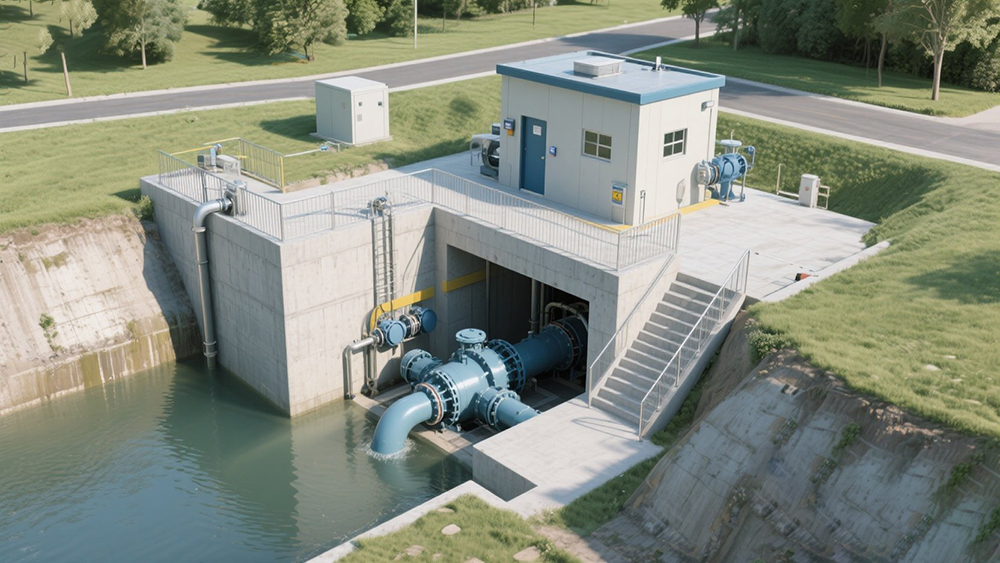+86 13816508465
May. 27, 2025

Pump rooms play a critical role in managing water flow for various sectors, from urban infrastructure to agriculture and industrial facilities. Among their many designs, the semi-underground pump room offers a unique blend of efficiency, protection, and adaptability. But what exactly is a semi-underground pump room? What principles underpin its operation, and where is it most commonly used?
This guide will explore the defining features, working principles, structural components, and practical applications of semi-underground pump rooms. Whether you're an engineer, contractor, or someone curious about modern water management systems, you'll walk away with a solid understanding of why this design is gaining traction.
What Is a Semi-Underground Pump Room?
A semi-underground pump room is a pump station partially constructed below ground level, marrying the advantages of accessibility with protection and environmental harmony. Unlike fully above-ground pump rooms that may face temperature fluctuations and visual disruption, or fully underground designs that can be costly to maintain, the semi-underground variant strikes a middle ground.
· Definition: A facility designed to house water pumps, partially built below ground to benefit from temperature stability, noise insulation, and protection from external elements.
· Why It Is Used: Semi-underground designs are ideal for installations in space-limited urban areas, environmentally sensitive locations, or regions prioritizing thermal and structural efficiency.
· Design Advantage: This approach minimizes the structure’s visual impact, reduces noise disturbances, and offers easier access for maintenance compared to underground alternatives.
Working Principle of a Semi-Underground Pump System
The functioning of a semi-underground pump room revolves around the efficient intake, management, and distribution of water. Here's how these systems work:
1. Water Intake via Suction Well
The suction well stabilizes the incoming water, ensuring a consistent and sufficient water level. This process prevents cavitation (air bubble formation), which could cause mechanical damage to the pumps.
2. Efficient Pumping and Distribution
High-performance pumps draw water from the suction well and push it through pipelines for specific applications such as irrigation, drainage, or industrial operations.
3. Electrical and Control Systems
Modern semi-underground pump rooms rely on electrical setups to regulate pressure, flow rate, and safety features. Automation systems play a key role, enabling the pump room to work in cycles or match the demand in real-time.
4. Energy Optimization
With advanced automation, semi-underground systems are designed to prevent energy waste. Variable frequency drives (VFDs) are often used to adjust pump speeds based on current water needs.
These interconnected principles ensure reliable water management while keeping costs and environmental impact under control.
Structural Components
A well-engineered semi-underground pump room consists of several core sections, each crucial to the system’s seamless operation:
Suction Well
· Purpose: Acts as the first point of water intake, stabilizing water flow and reducing the risks of pump cavitation.
· Design: Carefully constructed to maintain a consistent water level and improve the life span of the pumps.
· Functionality: Often includes grates or sediment traps to prevent debris from damaging downstream equipment.
Pump Equipment Area
· Essential Gear: Hosts pumps, suction and discharge piping, flow meters, and control valves.
· Backflow Prevention Devices: These setups ensure water flows in only one direction to reduce contamination risks.
· Additional Features: May include pressure tanks for enhanced water distribution and noise dampening measures to minimize operational disruption.
Power and Control Section
· Electrical Components: Houses distribution panels, control switches, and logic circuits to manage pump startup and shutdown.
· Remote Monitoring: Modern systems often include IoT-enabled sensors for monitoring pressure and flow from a distance.
· Safety Features: Includes an emergency power supply to ensure uninterrupted operation during outages.
Key Benefits of Semi-Underground Design
Semi-underground pump rooms offer a host of benefits that make them a preferred option for many applications:
· Space Efficiency
Perfect for urban areas and locations with limited land availability, as these designs require a smaller footprint.
· Thermal and Environmental Protection
Partially embedding the pump room below ground provides natural insulation against temperature fluctuations and harsh weather.
· Noise Reduction
By housing noisy equipment partly underground, the system minimizes noise pollution, making it suitable for use in parks, residential areas, or recreational facilities.
· Aesthetic Integration
Semi-underground designs reduce visual impact, blending seamlessly into public spaces such as landscaped parks or urban surroundings.
· Simplified Maintenance
Unlike fully underground systems, semi-underground setups provide easier access for routine inspections or repairs.
Typical Applications
Semi-underground pump rooms are highly versatile, serving a range of functions in different environments. Here are some of the most common applications:
Municipal Drainage and Stormwater Management
Handling urban flood mitigation during heavy rains by quickly channeling stormwater away from streets and properties.
Agricultural Irrigation Systems
Providing consistent water supply for large-scale farming by efficiently distributing water to crops via pipelines.
Sports Fields and Park Sprinklers
Ensuring the proper irrigation of sports fields and public parks, keeping grass lush and green while conserving water with controlled systems.
Industrial Water Transfer and Treatment Facilities
Facilitating bulk water movement in manufacturing plants or treatment facilities for cooling, processing, or waste management.
Water Features and Lakes
Powering artificial features like fountains, waterfalls, or lake circulation systems to keep the water clear and aerated.
Why Semi-Underground Pump Rooms Matter
Semi-underground pump rooms embody a thoughtful balance of functionality, design, and efficiency. They not only optimize water management but also contribute to noise reduction, environmental protection, and public aesthetics. For engineers, contractors, and municipal decision-makers, understanding how these systems work provides a foundation for smarter, more sustainable infrastructure projects.
Looking to learn more about optimizing water systems or planning a semi-underground pump room for your next project? Keep exploring our resources for expert insights and practical advice.
Address
No.17 XeDa Jimei Ind. Park, Xiqing Economic Development Area, Tianjin, China
Telephone
+86 13816508465
QUICK LINKS